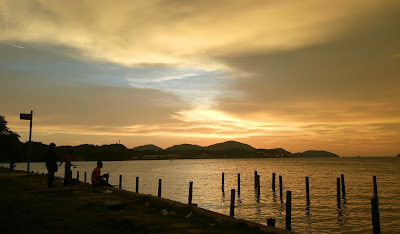---------------------------------------------------------------------------
Simon began his father’s story.
“It was late 1942. The time of the Japanese occupation of Malaya during World War II. My parents are originally from Kluang. According to my father, he was about 5 or 6 years old at the time. My grandfather had a small provision shop near Kluang town which he operated from a rented lot owned by a respectable Malay man named Pak Haji Rashid. The landlord’s own house was located behind the shop lot, meaning that my grandfather and Pak Haji Rashid were in fact neighbours.
It was a very hard life in those days. My father said the Japanese soldiers were extremely cruel. They were especially merciless against people of the Chinese race. They would arrest and torture anyone whom they suspect is opposing them. My grandfather had seen a few of his friends lose their heads at the stroke of the samurai sword. Business premises owned by the Chinese were plundered and taken over at will. Even schools were not spared. When they ran out of firewood, the soldiers took some wooden chairs and desks from the local Chinese school. The chairs and desks from the upper floor classrooms were simply tossed over the balcony so that they crash and splinter to the ground below. Easier to burn, they said.
To avoid capture, many able-bodied men ran into the nearby jungle to hide and fight back. My grandfather was sympathetic to the cause and he secretly helped the fighters by providing basic necessities. Of course, this was a very dangerous thing to do. If the Japanese found out, he would definitely lose his life.
Indeed, this was what happened. Somehow, information about my grandfather’s activity was leaked to the Japanese and word was out that the soldiers wanted his head. That particular evening, my grandfather was hiding in the shop together with my grandmother and my father. He didn’t know what else to do. He heard a sharp knock at the back door and the voice of his neighbour, Pak Haji Rashid. My grandfather opened the back door and Pak Haji Rashid told the whole family to leave the shop and follow him to his house. The Malay gentleman had offered to hide his neighbours from the search party. Using two large mengkuang mats, he rolled my grandmother and my father in one and my grandfather in the other. He placed the rolled-up mats, squeezed between a clothes cupboard and a sidewall. He told the family of three to be quiet. Be very quiet.
My father remembers this episode quite vividly. It was dark. It was hard to breathe. He wanted to cry. He wanted to pee. He hugged his mother as hard as he could.
The Japanese soldiers came. Broke into the shop. Ransacked the place. Not finding their intended targets, they took away whatever little provisions the small store had left. Somehow, they did not search the Malay man’s residence at the back.
The following morning, Pak Haji Rashid made arrangements to transport my grandfather and his family out of Kluang. My grandfather had relatives in Johor Bahru. That was where he would hide. Before leaving, my grandfather told Pak Haji Rashid that he and his family owed him their lives. How can he ever repay such debt of gratitude? The landlord had put his own life in danger in helping out his tenant. The Japanese would have surely executed him too had they found out.
My father told me he remembered Haji Rashid’s reply very clearly. You do not owe me anything, the Malay gentleman had said. But if you wish to repay me, then just repay mankind in general. Help out those in need, even if they do not ask for it.”
Simon paused his narration. He was looking at nothing in particular in the distance.
After a silent moment, he made a slight shake of his head, picked up his teh tarik mug and took a long sip of the already cold drink.
He then looked at Suresh and me before saying, “And that is why I am here today with you, my friends. My father remains alive and healthy to this day because a kindhearted man made a decision to help someone in need, even though that someone had not asked for it.”























